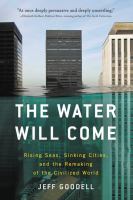The Water will Come: Rising Seas, Sinking Cities, and the Remaking of the Civilized World by Jeff Goodell
Flash forward to 2050. Most of Blaine and Birch Bay are underwater, as are Sandy Point, big sections of Slater and Ferndale roads, Squalicum Harbor, the new waterfront development, the Bellingham Cruise Terminal, and parts of Fairhaven—to name a few places in Whatcom County.
This is the future indicated by Surging Seas, an interactive map created by the website Climate Central, where visitors map potential sea level changes based on whether we continue current behaviors or make carbon cuts.
It is a future that is difficult to imagine, a mere several decades from now. To learn more about the factors impacting this predicted change and why, how and where it may happen, journalist Jeff Goodell’s critically acclaimed book, The Water will Come: Rising Seas, Sinking Cities, and the Remaking of the Civilized World is a great starting point. In it, he stresses that the question is not “if” the water will rise, but “how fast” and “how high.” Goodell is a contributing editor at Rolling Stone, and has covered climate change for 15 years.
In Goodell’s prologue, he imagines Miami in 2037 after a fictional hurricane and its subsequent sea-level rise render the city largely underwater. A wastewater treatment plant is knocked out and cholera becomes a very real threat. A nuclear reactor is damaged, enveloping the city in a radioactive cloud. Clouds of mosquitoes spread Zika and other viruses. It is an effective attention-getter, well within the realm of imagination after the intensity of recent hurricanes Irma, Harvey, and Maria.
Traveling to cities in peril in 12 countries to assess impacts of rising seas, Goodell points out that the hardest hit would be poorer populations in areas least equipped to deal with infrastructure problems. Whole islands may be submerged, and residents of coastal cities in the developing world displaced, creating as many as 200 million climate refugees by 2050, according to one estimate.
Scientists have posited that sea levels might rise a little more than three feet by 2100, but many now believe that six feet is a better estimate. A sea-level rise of six feet would affect one out of eight homes in Florida. Despite this, here in the United States, there are plenty of climate change deniers, and coastal city developers focused only on short-term gains. When Goodell asks an influential developer in Miami how he can keep investing and building considering this possible future, he responds with a flippant “By that time, I’ll be dead, so what does it matter?”
As the reality of this possible future enters our collective psyche, works of fiction are also starting to explore these high-water scenarios. American War by Omar El Akkad imagines America in 2075, in civil war over disagreements about our use of fossil fuels and with much of the coastline as we know it underwater. Other excellent dystopian novels set in climate change-induced rising seas are The End We Start From by Megan Hunter (London underwater) and New York 2140 by Hugo and Nebula award-winning science fiction author Kim Stanley Robinson.
For further nonfiction exploration of climate change encompassing multiple perspectives on the issue, search the library catalog for the subjects “climatic changes” or “paleoclimatology.”
Lisa Gresham is the Collection Support Manager for Whatcom County Library System. She lives at ~600 feet above sea level and is working to reduce her carbon footprint.
(Originally published in Cascadia Weekly, Wednesday, January 24, 2018.)

